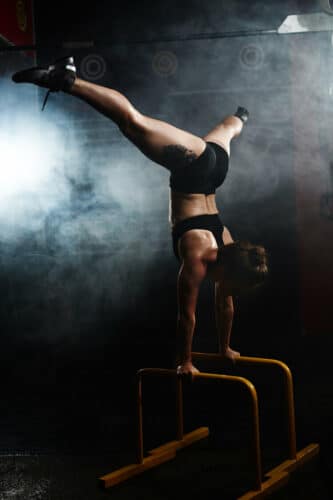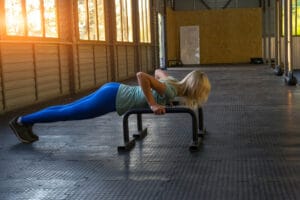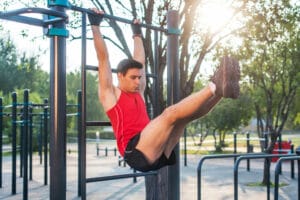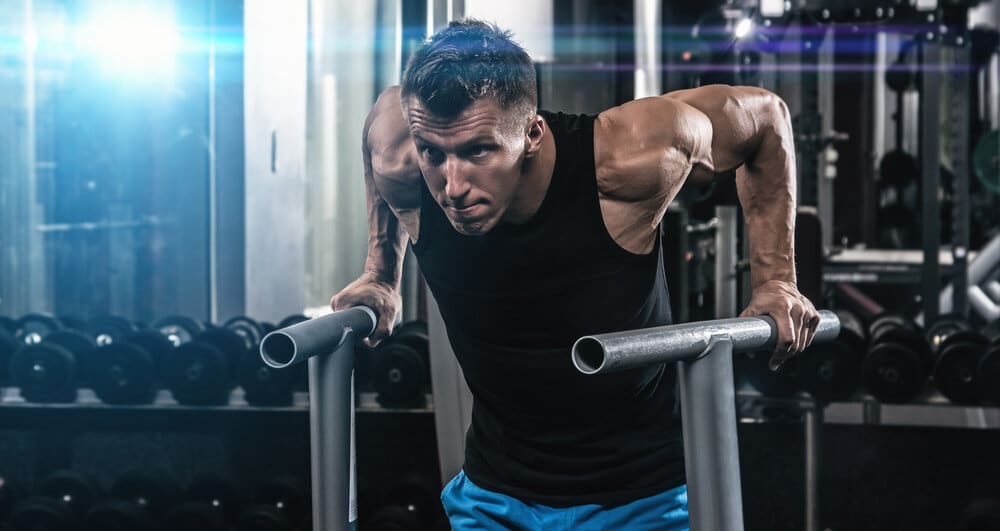Gymnasts have some of the best physiques in sport. Their core muscles are whittled into defined peaks and troughs, their backs and shoulders are sculpted and their arms have an ox-like strength, propelling them into the air with fluidity and ease.
The secret to their Michelengelo-style proportions is simple: Using your own body as a weight to develop the lean, functional muscle you see on the likes of Olympic athletes Rebecca Downie and Max Whitlock, rather than throwing heavy weights around in the gym.
While you’ll likely catch them drilling through moves on the rings and the beam, there’s another weapon gymnasts rely on to keep their strength in check. They’re called parallette bars and, if you go to the gym, you’ve probably seen them stacked up next to the weights and kettlebells.
“Parallettes are really just what the name suggests – mini versions of the parallel bars that you may remember from your school gym hall days,” says Luke Worthington, an elite trainer at Third Space gyms (thirdspace.london).
“If Louis Smith’s impressive physique is anything to go by, it’s pretty safe to say gymnastic movements can feature right up there with weight training when it comes to exercise choices for building lean muscle.”
While they might look small, innocent and unassuming (and like the bars you’d chain your bike to), they’ll give you a blistering workout that will make you sweat buckets and mumble profanities at your aching muscles the day after.
A session will work your upper-body, adding fire to your shoulders, back, chest, arms and abdominals.

They’re great for building up your upper body strength (Thinkstock/PA)
Parallette movements are called ‘calisthenics’, the technical name for exercises that use your own bodyweight as a form of resistance.
Thanks to Instagram, they’re having a big resurgence on the fitness scene, with influencers like Frank Medrano (@frank_medrano) and Kenneth Gallarzo (@progressive_calisthenics) showing off acts that defy gravity on railings, lamp posts and car bonnets.
Gymnasts will typically use parallettes to perform handstands and more complicated inversions, but the beginner gym-goer can still reap big benefits.
Add a set of bars into push ups, tricep dips, mountain climbers, standing lateral planks and lunges with one leg on the bar. The added elevation engages a wider range of muscles, bringing a higher level of intensity to a workout and training all the right body parts so you can eventually work towards getting your feet off the ground.

Start off by incorporating parallette bars into your push ups and mountain climbers (Thinkstock/PA)
Once you’ve mastered the basics, you can try standing between both bars, getting a double-handed grip and hovering your legs off the ground for 10 seconds. With enough practice, you can eventually attempt a tricep dip while suspended in the air.
If you’re thinking of incorporating the bars into a weight training routine, make sure you hit them fresh, preferably before you start repping through bicep curls with a set of dumbbells. “Parallette work should always feature at the beginning of the training session,” says Worthington. “It requires the highest level of motor control and will be the most physically challenging – these are not movements you should attempt when fatigued after a hardcore session.”
As parallette bars are cheap, portable and easy to use, Worthington says that getting familiar with them can save you money in the long run. “Once you’re able to make the transition to bodyweight-based equipment, you can become free of the confines of gyms and purpose-designed exercise spaces. If you can manoeuvre your bodyweight around a fixed anchor, then anything from a door frame, to a staircase, to a tree becomes your playground.”

You can use parallette skills just about anywhere (Thinkstock/PA)
Undoubtedly the best thing about the parallettes is that hardly anyone in your gym will have a clue what they’re for, so while everyone else is queuing for the chest press, you can skip the line and get right to it with some elevated press ups. Job done.
